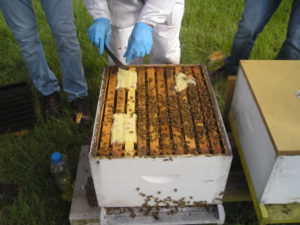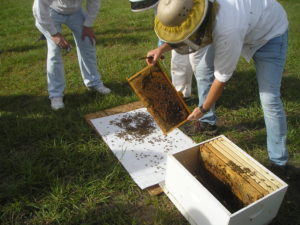It was the tumultuous beginning to a long-awaited Florida Fall. Hurricane Michael headed toward the state’s panhandle in early October 2018 . Only a few short weeks previously, the grand opening of the honey bee Research and Extension Laboratory at the University of Florida took place with great fanfare.
Front of the new honey bee lab at the University of Florida.
The new lab wasted little time getting on the world’s honey bee research and extension stage via an invitation extended to the Small Hive Beetle Task Force of what is known as COLOSS (prevention of honey bee COlony LOSSes, www.coloss.org),. This was the first time an international event of this nature would be held in the U.S.A.
A unique international association, COLOSS is a non-profit entity governed by the present statutes and, secondarily, by Articles 60 et seq. of the Swiss Civil Code. It is politically neutral and non-denominational. Originally a European Union initiative, it has now severed most of those ties and become an independent entity in its own right. The Association aims to improve the well-being of bees (in particular the western honey bee Apis mellifera) at a global level by advocating for honey bees through various governmental legislators and administrators. It helps coordinate international research efforts and disseminates knowledge and training related to apiculture, and in the process promotes youth development and gender balance among those studying, or actively involved in promoting, honey bee health.
Based in Berne, Switzerland, COLOSS is composed of scientific professionals (e.g. researchers, veterinarians, extension agents, etc.) and students that are actively involved in researching honey bees and their culture. Members may be from any geographic region. Requests to become a affiliated can be addressed to the Executive Committee. The Association’s resources come from membership fees, grants and donations, and earnings from workshops, conferences and other events.
Currently COLOSS has 1200 members from 95 countries and a growing list of special task forces, which include Varroa mite control, honey bee toxicology, bee breeding, and pollen diversity in bee nutrition, among others. Two of the most recent concern the Asian hornet (Vespa velutina) recently found in Europe, and now, the subject of this workshop, the small hive beetle (Aethina tumida) now detected in Italy.
COLOSS has a number of projects in the mill, but it’s most significant is publishing what is called the BEEBOOK, a unique venture that aims to standardize research methods. This practical manual has compiled close to 1700 standard methods in fields of honey bee research and seeks to be the definitive, still-evolving, how-to-do-honey-bee-research document. Presently BEEBOOK is composed of three volumes, which consist of 31 peer-reviewed chapters, authored by 234 of the world’s leading honey bee experts, representing 34 different countries.
This three-day small hive beetle workshop featured a jam-packed program, including lectures, demonstrations, training sessions, small-group brain storming and a Skype session from Italy. Finally, there was time for some intensive socializing to compare notes and the meeting was topped off by a visit to one of the premier beekeeping supply houses in the central part of the state.
The program was headlined by Amanda Hodges of the University of Florida Entomology and Nematology Department, who heads the University of Florida, Biosecurity Research and Extension Laboratory. She has authored and co-authored over 100 extension publications related to arthropod diagnostics and invasive species.
According to Dr. Hodges, the scale of introduced arthropods in Florida is extensive, with something like 2.5 species per month being detected at the state. A major port of entry is the Miami area with its great number of shipping arrivals and an international airport. A major risk at the moment is related to imported cut flowers. Exacerbating this process are the effects of climate change in Florida and something called “propagule pressure,” which is quite high in the Sunshine State. This can be boiled down she concluded to “bugs like it hot.”
Dr. Hodges stated that in spite of a number of introductions that have caused concern, there are recent examples of biological control that are working, including potential breeding for tolerance to soybean rust and introduction of insects that feed on a plant called “Florida’s Kudzu,” the introduced air potato. The best defense she concludes is early detection and going for eradication at the beginning of an outbreak rather than later. These strategies are easier said than done, and presently neither of these are practical for small hive beetle in Florida.
The history of small hive beetle in Europe appears to center around recent introduction into Italy at the present time, where surveillance is continuing. Peter Neumann, President of the Association, took a look at early detection. The beetle has now been found on all continents so this has not worked well in most affected areas. Several problems have surfaced including failure to reimburse beekeepers in Italy and elsewhere for losses due to attempts at eradication, identification issues (false negatives), and breakdown in communication between beekeepers and regulators.
Discussion revealed that beekeepers and researchers quickly move on to controlling the beetle when it becomes apparent that early detection has failed. Trapping continues both for detection and treatment. The best trap is a live beehive. Other in-hive traps are potentially valuable and several are found on the market. Soil treatment using permethrin is gaining some proponents (Guard Star® is one permitted use) , as is keeping bees out of the shade, where beetles appear to be more prevalent and active. Finally deploying Brawny Dine-A-Max paper towels®, which entangle beetles is also used as a control measure by some beekeepers.
Certain paper towels on the top bars actively entrap beetles
There continues to be no good threshold data (number of beetles causing significant harm) consistent with damage to a honey bee colony, an important consideration for those looking to use integrated controls. Correlation with colony collapse disorder (CCD) is also unknown. Sampling to determine populations of beetles in colonies is not definitive without heroic measures used in research colonies as demonstrated at the meeting. There’s also no answer to determine what initiates egg-laying by female beetles or what bee or beetle demographics affect populations.
Here the “shake and bake,” deposits all bees onto a counting board, separating them from beetles.
In-hive treatment with a chemical called fipronil is now a widespread “off label” use, especially in the U.S. Because it can kill bees and potentially contaminate hive products, honey bees must not be allowed to contact the material, which is often deployed in CD ROM cases that only the beetles can fit into. Screened bottom boards are also in use, but their effectiveness has not been determined. It was emphasized that there is no labeled chemical control for small hive beetle.
So far, perhaps the best control method is a strong bee hive, with a high bee to comb ratio. Small mating nuclei are especially vulnerable. In conclusion, the amount of still unknown information about small hive beetle biology, as well as detection and potential control means that a huge research effort is needed, a major goal tailor made for the task force to tackle.
There are areas of the world where small hive beetle is not problematic. These include its native South Africa and other places inhabited by tolerant honey bees.
Dr. David de Jong of the University of São Paolo at Ribeirão Preto Brazil provided a discussion of the beetle in Mexico (Coahulia 2007) and (Yucatan 2012) where there are few problems at the moment, presumably due to being populated with Africanized honey bees. The dry soil conditions found in those areas may also be responsible for minimal beetle larval development. Now found in both São Paulo and Rio de Janeiro states, few Brazilian beekeepers report problems with the beetle, basically reiterating the idea that the Africanized honey bee is not affected to any degree in those regions. There are no reports that the stingless bee population in Brazil is affected.
Several areas of ongoing research were revealed at the meeting. Audrey Sheridan of Mississippi State University is looking at sex pheromones and other chemical or possibly physical attraction in beetles. The males emerge first after pupation; females might produce a sex attractant. If so, can it be characterized? There could in fact be none, and some other way of attracting males to females is employed. Possible triggers might include using antennae in yet unknown ways and/or use of an alternative pheromone, such as honey bee “footprint” substance. Homosexual activity may be involved (or not) and why is there no egg-laying observed in winter? This is a tropical insect, which might provide part of an answer to that query.
Charles Stuhl of the U.S. Department of Agriculture (ARS) laboratory on the University of Florida campus provided an update on producing a bait that might attract and kill beetles manufactured from a yeast that is associated with the beetle. This research has been going on for a time under direction of the late Peter Teal, who has a room named after him in the new laboratory. It looks like significant progress might well be announced soon. Apparently a manufacturer for the bait is being sought.
Karsten Stief, Veterinaeramt Heidenheim, Felsenst., Germany is designing a larval trap. Because larvae have to leave the colony to pupate, this is one area where they are vulnerable. In some honey houses, larvae that leave filled supers are attracted to light on a concrete floor and can then be shoveled into water where they drown. The experimental trap is testing just how mobile larvae can be. Questions persist about how they climb out of their own “slime.” Is it possible to perhaps even eradicate the beetle via an efficient larval trap?
A Skype call from Giovanni Formato, a veterinarian in the Istituto Zooprofilattico Sperimentale del Lazio e Toscana · Apiculture Unit, discussed a number of diagnostic tools being used for small hive beetle. These include expanded beehive inspections, but they are hampered by inclement weather, which is time consuming, and suffer from lack of collaboration between beekeepers and authorities.
Other areas of research include evaluating inside-the-hive traps mentioned before, and seeing what can be done via soil treatments (fungi that are plant extracts). The latter can be manufactured from materials that are already registered for use in organic agriculture. Nematodes are also not being ruled out.
With the preliminaries out of the way, the meeting turned to a listing of specific projects that the task force could take on. An annotated bibliography was suggested along with a listing of current regulations already in force in specific geographic regions. The latter idea resulted from experiences where uninformed bureaucrats made decisions based on incorrect or outdated information. Others included a standardized rearing procedure and genetic testing protocol, perhaps needed to see what variants of the beetle exist around the world. Finally a comprehensive review article is needed, something the COLOSS group is adept at producing.
The final minutes of the meeting showed the final tasks selected:
TASK A: Ring test for molecular diagnostic tool(s): Need a standardized diagnostics procedure for small hive beetle.
Questions to be looked at: (1) how to get a good DNA sample from colonies (bees, debris, from flowers, from other bees; what matrix is best to sample? how sensitive is the test?), (2) test a variety of molecular markers, (3) test a variety of beetle sources, (4) make sure test is robust enough to limit false positives/negatives (by including other Aethina species). An Elisa test or LAMP may currently be in progress?
TASK B: Tools for Small Hive Beetle Management
Much like that produced by the Honey Bee Health Coalition for Varroa, small hive beetle information needs to be consolidated into a single source.
Questions to be looked at: (1) What is alarming and what is not (i.e. what is “normal” or acceptable when beetles are present?) (2) What options (in and outside hives, i.e. honey houses) exist for control measures? (3) What basic beetle biology life cycle steps are not known?
It was noted that sources for small hive beetle information already exists. Present at the meeting was Michael Hood, Professor Emeritus at Clemson University whose book: The Small Hive Beetle, Aethina tumida Murray was published by Northern Bee Books in 2017. His Top Twenty Small Hive Beetle Management Recommendations presumably would be a basis for many of the tools eventually developed.
TASK C: Determine in-hive trap efficacy
Need a list of available traps and their relative effectiveness.
Questions to be looked at: (1) Which traps to test?, what standardized protocol(s?), various attractants, what killing agents to use? (2) How traps can be used for diagnostic purposes and for management purposes?
TASK D: Review article listing predictive markers for colony collapse due to beetles
Need definitive answers as to how small hive beetle and Colony Collapse Disorder (CCD) might be related.
Questions to be looked at: (1) Are there potential triggers/predictive markers for Colony Collapse Disorder ? (2) What predisposes a colony to host beetles (i.e. what attracts them to colonies vs apiaries)? and (3) What predisposes colonies to collapse?
In addition to the tasks above, the following organizational actions are or will be put into play:
1. Develop an annotated bibliography (Endnote, Google Drive, Zotero, Password Protected. (Completed Oct 10th 2018)
2. Develop a picture database of small hive beetle (see COLOSS website, bugwood, (others can link their albums here)
Update the COLOSS webpage with appropriate details.
The final day of the meeting as the hurricane began devastating Florida’s panhandle, was given over to a visit to D&J Apiary near Umatilla, Florida. The trip and site visited was far away enough from the storm not to be affected.
Umatilla has long been a focal point for beekeeping in Florida based on the extensive citrus plantings in the area. Devastating freezes in the late 1980s took out most of the orchards and much of the citrus industry abandoned the area, moving south of Orlando. D&J continues its over 30 years of service to beekeepers in the region and state. and puts on a number of classes for the beekeeping public.
The Small Hive Beetle Task Force meeting sported over twenty participants from as far away as Nigeria. There are approximately 70 members in total contributing to its mission.
Fortunately, the program now has a willing ally in Florida with considerable resources at its disposal, the brand new honey bee laboratory. Everyone is invited to visit.
The next Small Hive Beetle Task Force meeting is scheduled for 9 and 10 October, 2019 in Lamezia Terme, Italy. There will also be discussions at the next annual COLOSS meeting, to be held next September in Montreal as part of Apimondia 46.
Originally brought to you courtesy of Bee Culture Magazine (February 2019) leader in experimental electronic beekeeping information, including the award-winning Catch The Buzz




